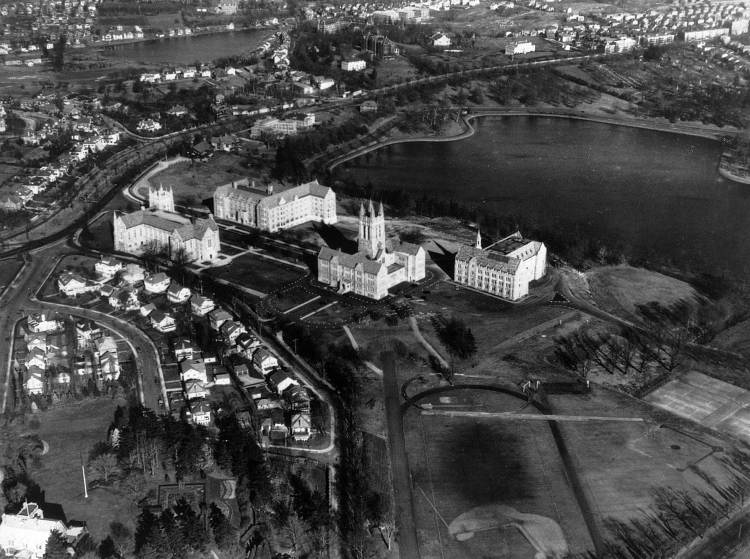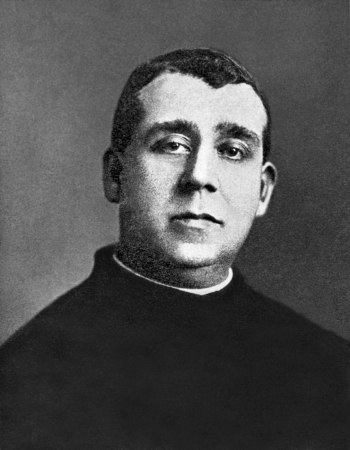
The following article is taken from an essay by the late University historian Thomas H. O’Connor.
It is one of the most compelling, often-told chapters of Boston College’s long and storied history: An all-but-bankrupt BC, its future rumored to be in doubt, staves off disaster and gradually emerges as an elite university.
But this recent era of transformation, which began in the early 1970s, was only one of several points in time when BC overcame significant challenges, in some cases facing the very real prospect of shutting down. Instead, Boston College grew from a school founded to serve the sons of Boston Irish immigrants to one of the world’s leading Jesuit, Catholic universities — one of the greatest success stories in American higher education.
Like most success stories, BC’s is full of triumphs and setbacks, bold decisions and ambitious moves, and many dynamic personalities that led the school through 150 eventful years marked by two world wars and a bevy of social changes in the US and the American Catholic community.
When the school opened its doors on September 5, 1864, only 22 young men showed up to partake of this bold new experiment. In his diary, Rev. Robert Fulton, SJ, the first dean of Boston College, offered a candid assessment of the first students: “Many came gratuitously, and only one or two had talent.”
The reality, however, was that their parents were poor, uneducated Irish immigrants who, as Fr. Fulton realized “were not eager to pay for what could be had for nothing in the schools and academies of the city.” Nonetheless, they possessed a deep, abiding faith in Catholic education and in the Jesuits who offered it. And so, from the humblest beginnings, Boston College was born.
The student body would grow by approximately 15 students each year during its first 10 years, before experiencing steady growth during the next three decades. This trend would end upon the turn of the century when it became clear that the school had outgrown both its original structure and the South End, which had fallen into a state of neglect with the advent of the more fashionable Back Bay.

As a result, Boston College President Thomas Gasson, SJ, made the decision to purchase the “magnificent site on Commonwealth Avenue toward Brighton,” to house the new Boston College. He developed a plan for a campus on the former Lawrence Farm consisting of 15 buildings in the English Collegiate Gothic architectural style that would serve as an American Oxford, breaking ground in 1909, with the first building, then known as the Recitation Building, opening in 1913.
His ambition, however, would exceed the school’s means, as BC would construct only three other buildings — St Mary’s, Bapst Library and Devlin Hall — before a lack of finances would curb its plans.
There would be, not surprisingly, other setbacks along the way.
During World War I, enrollment, which had stood at 671 in the fall of 1916, would fall to 125 in 1918, a loss of 81 percent. Had the war not ended that year, the college may well have closed.
Twenty-five years later, this scenario would repeat itself with the outbreak of World War II. By April of 1944 enrollment, which had exceeded 1200 in 1941, had fallen to 236 students, and the Jesuits again faced the grim reality that the college could not sustain itself. Their fortunes were reversed only by the Army Specialized Training Program and the allied victory in 1945.
After World War II, Boston College would surge in enrollment thanks to the GI Bill and the dedication of its Jesuit and lay faculty who would steer the school through the next 25 years of transition from a college to a university. Having added the Law School and Evening College in 1929, the Graduate School of Social Work in 1936 and the College of Business Administration in 1938, Boston College would further fill out its charter as a university during the post-war years, adding schools of Nursing and Education in 1947 and 1952, respectively. Graduate and doctoral programs would soon follow.
And yet, by the late 1960s, the upward social mobility of Boston’s ethnic Catholic population would provide options for college-aged males that enabled them to look beyond the city’s premier Catholic college, setting the stage for Boston College’s most serious financial challenge.
The numbers paint a clear picture. In 1973, Boston College’s was on the verge of bankruptcy. It had a negative net worth and had experienced five consecutive years of major deficits. The endowment was $5 million. Faculty salaries were at the 50th percentile of Category I universities. Undergraduate applications totaled 8,400. Nearly 90 percent of its students came from New England, New York and New Jersey. There were hushed whispers among faculty and staff that the school might not survive.
Fortunately, through excellent leadership and strong fiscal governance in BC Presidents J. Donald Monan, SJ and William P. Leahy, SJ, dedicated faculty, and the generosity of BC alumni, Boston College staved off bankruptcy and began its transformation from a regional to a national and ultimately an international university.
Today, Boston College has an annual budget of $862 million and its endowment is among the 40th largest in the United States. Undergraduate applications have surpassed 34,000, making BC among the most applied-to private universities in the nation. BC students come from all 50 states and 60 countries. Faculty are compensated in the 90th percentile of Category I universities. Boston College is now one of only 21 private universities in the United States that is need blind and meets the full demonstrated financial need of all accepted students, awarding $90 million in need-based financial aid for undergraduates, and $143 million overall.
BC’s student profile is also among the most selective in the United States. Average SAT scores stand at 2020 on the 2400 scale, and 80 percent of incoming freshmen are in the top 10 percent of their high school classes. BC student athletes continue to be ranked in the Top 10 NCAA Division IA programs in graduation rates.
To continue its momentum, in 2007 Boston College announced its $1.6 billion Strategic Plan, which calls for increases in faculty, endowed chairs and academic centers.
To provide the infrastructure to support the Strategic Plan, the University’s Institutional Master Plan will add new academic buildings, a student center, recreation complex and fine arts district, as well as beds to meet 100% of undergraduate demand. The first academic building, Stokes Hall, a 183,000-square foot humanities building, will open in January, and the 65-acre Brighton Campus has been transformed into a vibrant and integral part of the BC campus.
The bold experiment, first conceived by its Jesuit founders, has succeeded beyond their loftiest aspirations. Boston College has indeed fulfilled its motto of “Ever to Excel.” And, clearly for BC, on the verge of its 150th anniversary, the very best is yet to come.



